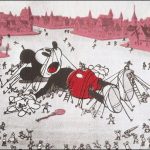

He’s here, he’s there! He’s Cubby Bear! Up in the air! Twice! Today our trail gives us the opportunity to compare two cartoons produced in short succession to one another, by two different studios, featuring the same character in attempts to break world aeronautical records, one horizontally, and one vertically. We’ll also enjoy visits with Mickey, Oswald, the Terrytoons dogs, and a couple of chances to follow the bouncing ball, all continuing on the central theme of leaving our casts weather-beaten and with a stormy disposition. Let’s rock and roll.
 World Flight (Harman-Ising/RKO, Cubby Bear, 8/24/33, I. Freleng/Paul Smith, anim.). Hugh Harman and Rudolf Ising (who receives entirely misspelled credit in this film as “Isling”) were between studios, having gotten the boot from Leon Schlesinger, and not yet finding an open door at MGM. Oddly, they found opportunity for farming out their labor for hire to Van Buren, taking on the task of producing a handful of episodes to supplement the output of the studio’s new star, Cubby Bear. It is unknown precisely why Van Buren would have needed outside assistance at this point in time. The studio was only slightly beginning to trend toward more advanced animation on the Cubby projects, under the influence of Mannie Davis, but perhaps the extra drawings needed were causing some degree of falling behind quota. Also, it is possible adjustments to the stylized design of the forthcoming Little King cartoons were also slowing the production pace. For whatever reason, Harman and Ising got the gig – but it soon became evident that they were not taking any great degree of effort either to analyze what little personality the Bear had, nor to replicate the drawing style of the Davis models. Instead, they merely grafted fur and ears onto a black body, but produced their films almost entirely as if they were still in assembly-line production of their Bosko cartoons – with Cubby merely Bosko in fur-face. It was no secret that their work was derivative of their past, as they went so far as to resort to their old tricks of reusing old animation, including multiple scenes and backgroinds from “Battling Bosko” and “Lady, Play Your Mandolin” (the latter particularly influencing a companion Cubby title, “Gay Gaucho”). Nevertheless, “World Flight” is probably their best effort for Van Buren.
World Flight (Harman-Ising/RKO, Cubby Bear, 8/24/33, I. Freleng/Paul Smith, anim.). Hugh Harman and Rudolf Ising (who receives entirely misspelled credit in this film as “Isling”) were between studios, having gotten the boot from Leon Schlesinger, and not yet finding an open door at MGM. Oddly, they found opportunity for farming out their labor for hire to Van Buren, taking on the task of producing a handful of episodes to supplement the output of the studio’s new star, Cubby Bear. It is unknown precisely why Van Buren would have needed outside assistance at this point in time. The studio was only slightly beginning to trend toward more advanced animation on the Cubby projects, under the influence of Mannie Davis, but perhaps the extra drawings needed were causing some degree of falling behind quota. Also, it is possible adjustments to the stylized design of the forthcoming Little King cartoons were also slowing the production pace. For whatever reason, Harman and Ising got the gig – but it soon became evident that they were not taking any great degree of effort either to analyze what little personality the Bear had, nor to replicate the drawing style of the Davis models. Instead, they merely grafted fur and ears onto a black body, but produced their films almost entirely as if they were still in assembly-line production of their Bosko cartoons – with Cubby merely Bosko in fur-face. It was no secret that their work was derivative of their past, as they went so far as to resort to their old tricks of reusing old animation, including multiple scenes and backgroinds from “Battling Bosko” and “Lady, Play Your Mandolin” (the latter particularly influencing a companion Cubby title, “Gay Gaucho”). Nevertheless, “World Flight” is probably their best effort for Van Buren.
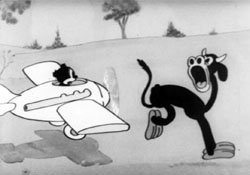 With a crowd-control assist from the four Marx Brothers, and some well-wishing from Charles Lindbergh and his plane, Cubby is off to break records on a round-the-world flight. He never actually circumnavigates the globe, cheating with a short-cut straight through the Earth, that allows him to make the return leg of the trip directly from China. Crossing the Atlantic from Europe, Cubby encounters a storm system determined not to let him complete his mission. Lighting bolts from a cloud form into the shape of a hand performing a deriding nose-wave, while another cloud forms a face which breathes lightning bolts like a dragon breathes fire. The bolts drill into the plane’s tail, zip between the plane’s legs, then form into circles with their jagged edges outwards like buzzsaw blades, sawing the wings off Cubby’s plane. The plane goes into a midair stall, its propeller keeping it aloft, but with no ability to steer. Quick-thinking Cubby grabs a passing pair of geese, setting them on the stubs of each wing and getting them to flap. The craft levels off and begins to make forward progress. But the storm won’t give up, and repeats action from an earlier Bosko, “Dumb Patrol”, first blasting away the fabric from the plane’s body with a lightning strike, then obliterating the plane itself with another. It looks like Cubby’s finish, but instead, it’s the finish line, as he has just reached his destination, and lands on one of the prongs of the crown of the Statue of Liberty. The Statue comes to life (with a basso voice, yet), and places Cubby on the pedestal surrounding her torch, singing Cubby’s praises, while the whole of Manhattan Island shouts in response (including a noticeable King Kong clinging to the Empire State Building), for the iris out.
With a crowd-control assist from the four Marx Brothers, and some well-wishing from Charles Lindbergh and his plane, Cubby is off to break records on a round-the-world flight. He never actually circumnavigates the globe, cheating with a short-cut straight through the Earth, that allows him to make the return leg of the trip directly from China. Crossing the Atlantic from Europe, Cubby encounters a storm system determined not to let him complete his mission. Lighting bolts from a cloud form into the shape of a hand performing a deriding nose-wave, while another cloud forms a face which breathes lightning bolts like a dragon breathes fire. The bolts drill into the plane’s tail, zip between the plane’s legs, then form into circles with their jagged edges outwards like buzzsaw blades, sawing the wings off Cubby’s plane. The plane goes into a midair stall, its propeller keeping it aloft, but with no ability to steer. Quick-thinking Cubby grabs a passing pair of geese, setting them on the stubs of each wing and getting them to flap. The craft levels off and begins to make forward progress. But the storm won’t give up, and repeats action from an earlier Bosko, “Dumb Patrol”, first blasting away the fabric from the plane’s body with a lightning strike, then obliterating the plane itself with another. It looks like Cubby’s finish, but instead, it’s the finish line, as he has just reached his destination, and lands on one of the prongs of the crown of the Statue of Liberty. The Statue comes to life (with a basso voice, yet), and places Cubby on the pedestal surrounding her torch, singing Cubby’s praises, while the whole of Manhattan Island shouts in response (including a noticeable King Kong clinging to the Empire State Building), for the iris out.
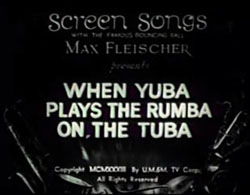 When Yuba Plays the Rumba on the Tuba – Fleischer/Paramount, Screen Song, 9/15/33 – Dave Fleischer, dir., Bernard Wolf, Thomas Johnson, anim.) – Sadly, no complete print of this film has to date surfaced, the existing copy missing all live-action footage of the Mills Brothers. They are, however, heard throughout the soundtrack, which, in what remains of the film, amounts to two short cartoons having nothing at all to do with one another – the first about a dirigible voyage, the second about a cat on a railroad hand car trying to outrun a locomotive. The first episode features two brief scenes of storm activity. One cloud passes below another, and is grabbed by the second cloud who assumes humanized form, and begins a street brawl with the first cloud, their punches producing lightning. The aggressor cloud grabs the other by the throat, turns him upside down, then squeezes him like a towel to ooze out his entire supply of rain. The bully cloud doesn’t even bother joining in the storm, but simply tosses the other cloud away, and reverts to normal form. The captain of the dirigible sails in POV shot directly into a cloudbank. The cloud develops a giant face as the dirigible penetrates it, then emits a lightning bolt to ignite the dirigible’s tail. Holding the other end of the airship in its mouth, it proceeds to smoke the ship like a cigar (a refinement of a gag which had previously been used in Van Buren’s Tom and Jerry short Trouble). The crew is forced to abandon ship, one good gag featuring a pig who jumps out of the gondola wearing a parachute, and pulls the ripcord. Instead of a chute opening, the cord turns out to be the stem of a funeral lily!
When Yuba Plays the Rumba on the Tuba – Fleischer/Paramount, Screen Song, 9/15/33 – Dave Fleischer, dir., Bernard Wolf, Thomas Johnson, anim.) – Sadly, no complete print of this film has to date surfaced, the existing copy missing all live-action footage of the Mills Brothers. They are, however, heard throughout the soundtrack, which, in what remains of the film, amounts to two short cartoons having nothing at all to do with one another – the first about a dirigible voyage, the second about a cat on a railroad hand car trying to outrun a locomotive. The first episode features two brief scenes of storm activity. One cloud passes below another, and is grabbed by the second cloud who assumes humanized form, and begins a street brawl with the first cloud, their punches producing lightning. The aggressor cloud grabs the other by the throat, turns him upside down, then squeezes him like a towel to ooze out his entire supply of rain. The bully cloud doesn’t even bother joining in the storm, but simply tosses the other cloud away, and reverts to normal form. The captain of the dirigible sails in POV shot directly into a cloudbank. The cloud develops a giant face as the dirigible penetrates it, then emits a lightning bolt to ignite the dirigible’s tail. Holding the other end of the airship in its mouth, it proceeds to smoke the ship like a cigar (a refinement of a gag which had previously been used in Van Buren’s Tom and Jerry short Trouble). The crew is forced to abandon ship, one good gag featuring a pig who jumps out of the gondola wearing a parachute, and pulls the ripcord. Instead of a chute opening, the cord turns out to be the stem of a funeral lily!
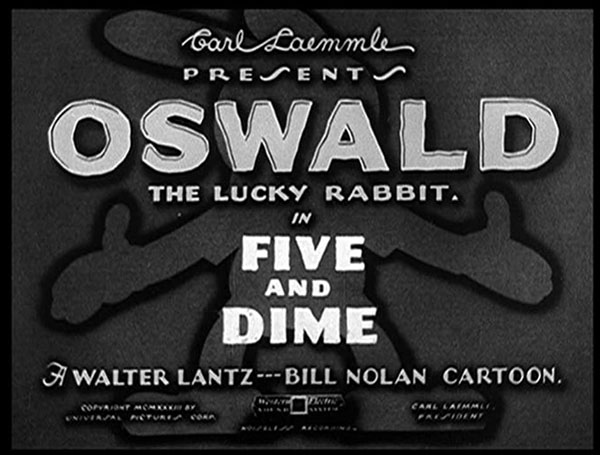 Five and Dime (Lantz/Universal, Oswald Rabbit, 9/18/33, Walter Lantz/Bill Nolan, dir.) – A better-than-usual Oswald, on which Tex Avery not only contributed, but provides a brief voice as old Doc Stork for the ending. It is framed upon the pop-song favorite, “I Found a Million Dollar Baby (in a Five and Ten Cent Store)”, a number popularized by many, including an early performance on Brunswick by Bing Crosby. Oswald is passing time in the city, enjoying music on the demonstrator model outside a radio store, when he is caught in a sudden downpour. In the skies above, an arena of small clouds are gathering around a boxing rinh, where two black clouds take center stage at the sound of a bell, jockey for position against one another with some fancy footwork, then connect in a blow to the chin that floods the screen with the white glare of a lightning strike. The rain begins pouring down heavily, coupled with a strong crosswind that causes passers-by to keel backwards if walking slowly or duck into low forward bows if trying to buck the wind. As in the lyric of the subject song of the cartoon, a five and ten cent store offers the “most convenient door” for Oswald to seek shelter from the storm. While many other people remain huddled in the doorway, attempting to wait the storm out, Oswald becomes curious, and decides to look inside the store. As he enters, his trousers are soaking wet, having taken on a good deal of water inside, and leave a large pudde visible on the floor around him. A passing cat reacts with disdain at the sight, uttering “Tsk tsk tsk.” Oswald spots a small laundry wringer on sale as a stand-alone model within the shop, takes the device through a door into a small room, then removes his trousers to wring out the water. Suddenly, he hears resounding laughter. Oswald looks behind him, to discover that the fourth wall of the small room is the glass of one of the display windows on the outside of the shop, and a crowd of people are staring and laughing at him” (An animation error almost spoils the gag, as an exterior shot through the window erroneously shows Oswald with his pants back on.) Oswald runs back into the store, and finally hops back into his trousers.
Five and Dime (Lantz/Universal, Oswald Rabbit, 9/18/33, Walter Lantz/Bill Nolan, dir.) – A better-than-usual Oswald, on which Tex Avery not only contributed, but provides a brief voice as old Doc Stork for the ending. It is framed upon the pop-song favorite, “I Found a Million Dollar Baby (in a Five and Ten Cent Store)”, a number popularized by many, including an early performance on Brunswick by Bing Crosby. Oswald is passing time in the city, enjoying music on the demonstrator model outside a radio store, when he is caught in a sudden downpour. In the skies above, an arena of small clouds are gathering around a boxing rinh, where two black clouds take center stage at the sound of a bell, jockey for position against one another with some fancy footwork, then connect in a blow to the chin that floods the screen with the white glare of a lightning strike. The rain begins pouring down heavily, coupled with a strong crosswind that causes passers-by to keel backwards if walking slowly or duck into low forward bows if trying to buck the wind. As in the lyric of the subject song of the cartoon, a five and ten cent store offers the “most convenient door” for Oswald to seek shelter from the storm. While many other people remain huddled in the doorway, attempting to wait the storm out, Oswald becomes curious, and decides to look inside the store. As he enters, his trousers are soaking wet, having taken on a good deal of water inside, and leave a large pudde visible on the floor around him. A passing cat reacts with disdain at the sight, uttering “Tsk tsk tsk.” Oswald spots a small laundry wringer on sale as a stand-alone model within the shop, takes the device through a door into a small room, then removes his trousers to wring out the water. Suddenly, he hears resounding laughter. Oswald looks behind him, to discover that the fourth wall of the small room is the glass of one of the display windows on the outside of the shop, and a crowd of people are staring and laughing at him” (An animation error almost spoils the gag, as an exterior shot through the window erroneously shows Oswald with his pants back on.) Oswald runs back into the store, and finally hops back into his trousers.
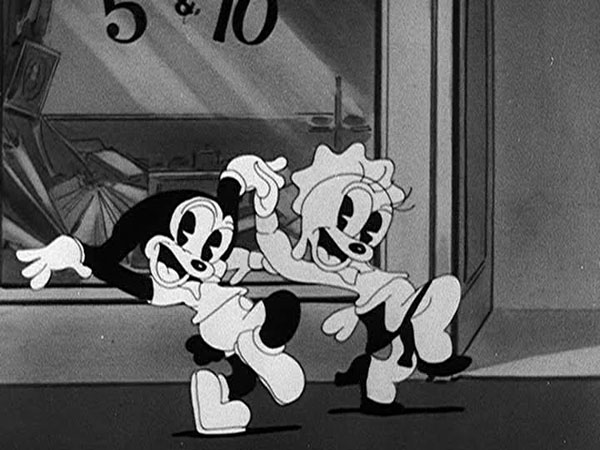 However, he has been caught in the act by a shop girl in charge of the sheet music department, who gives him a well-known gesture of running one finger atop the surface of another, indicating “naughty naughty.” Oswald briefly blushes with embarrassment, but makes the acquaintance of the girl, who asks if he can play piano. Oswald obliges, with a well-sung rendition of “Million Dollar Baby”. (While no source definitively assigns a voice actor as responsible for Oswald’s singing, I wonder if it could be a young Mickey Rooney, who is known to have worked on several Oswalds of the period.) The number sets the stage for a loose gathering of miscellaneous sight gags in the various departments of the store, most of them featuring a young tot raising havoc in the toy and pet departments. He allows a cat to almost swallow a mechanical mouse, then tries to make amends by leading the cat to goldfish in a bowl in the pet department – only to have the fish swallow the cat instead of the other way around. The tot tosses the fish at some Laurel and Hardy dolls in the toy department, who engage in a battle of their own over who threw the fish, resulting in the Laurel doll being knocked into a row of stacked china plates on a top shelf, which fall like dominoes, cracking-up everywhere. The tot finds himself outside the manager’s office at this crucial moment, and, to avoid responsibility for the damage, knocks over a statue of Venus de Milo, takes off hs own shirt, and hides his arms behind his back, assuming the position of the statue. He remains unnoticed by the manager – but the dish damage is plain to see. The manager pins responsibility for the incident upon Oswald and the shop girl, ejecting them from the store. Oswald is sorry that he cost the girl her job, but whispers in her ear a suggestion to solve her future security – a marriage proposal. The girl nods her consent. In a well-timed finale, filmed almost entirely as one long continuous shot, Oswald and the girl strut musically down the street to the same song, with new custom lyrics, entering and exiting a jewelry shop, a dress shop, and a tailor shop to allow them to emerge in wedding attire, continue trucking through a church for a quick ceremony, and straight to the door of their honeymoon cottage. Oswald ends the song with the line, “That’s all there is, there ain’t no more.” But the camera pans up to the roof, where old Dr. Stork waits by the chimney with medical bag, and addresses the audience with the knowing remark, “Oh, yeah?”, for a heart-shaped iris out.
However, he has been caught in the act by a shop girl in charge of the sheet music department, who gives him a well-known gesture of running one finger atop the surface of another, indicating “naughty naughty.” Oswald briefly blushes with embarrassment, but makes the acquaintance of the girl, who asks if he can play piano. Oswald obliges, with a well-sung rendition of “Million Dollar Baby”. (While no source definitively assigns a voice actor as responsible for Oswald’s singing, I wonder if it could be a young Mickey Rooney, who is known to have worked on several Oswalds of the period.) The number sets the stage for a loose gathering of miscellaneous sight gags in the various departments of the store, most of them featuring a young tot raising havoc in the toy and pet departments. He allows a cat to almost swallow a mechanical mouse, then tries to make amends by leading the cat to goldfish in a bowl in the pet department – only to have the fish swallow the cat instead of the other way around. The tot tosses the fish at some Laurel and Hardy dolls in the toy department, who engage in a battle of their own over who threw the fish, resulting in the Laurel doll being knocked into a row of stacked china plates on a top shelf, which fall like dominoes, cracking-up everywhere. The tot finds himself outside the manager’s office at this crucial moment, and, to avoid responsibility for the damage, knocks over a statue of Venus de Milo, takes off hs own shirt, and hides his arms behind his back, assuming the position of the statue. He remains unnoticed by the manager – but the dish damage is plain to see. The manager pins responsibility for the incident upon Oswald and the shop girl, ejecting them from the store. Oswald is sorry that he cost the girl her job, but whispers in her ear a suggestion to solve her future security – a marriage proposal. The girl nods her consent. In a well-timed finale, filmed almost entirely as one long continuous shot, Oswald and the girl strut musically down the street to the same song, with new custom lyrics, entering and exiting a jewelry shop, a dress shop, and a tailor shop to allow them to emerge in wedding attire, continue trucking through a church for a quick ceremony, and straight to the door of their honeymoon cottage. Oswald ends the song with the line, “That’s all there is, there ain’t no more.” But the camera pans up to the roof, where old Dr. Stork waits by the chimney with medical bag, and addresses the audience with the knowing remark, “Oh, yeah?”, for a heart-shaped iris out.
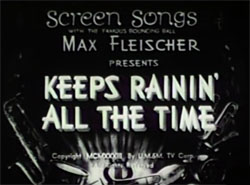 Keeps Rainin’ All the Time (Fleischer/Paramount, Screen Song, 1/12/34 – Dave Fleischer, dir., Seymour Kneitel/William Henning, anim.) – Yes, we currently know the featured tune as “Stormy Weather” – and in fact, it was generally titled as such on contemporary recordings of the day – so why exactly Fleischer chose its secondary line as title for this picture remains a mystery. Gertrude Niesen croons the tune to the bouncing ball. A small bear cub runs away from home, tired of his parents always pressuring him to eat foods he doesn’t like. The shoe is on the other foot when he finds an abandoned nest of baby birds, and has to find ways to coax them to eat worms. He also teaches them how to fly. As a rainstorm begins, the cub copies the behavior of a mother hen, running for the shelter of a small tree with the chicks following, huddled under his belly for protection. The cub adjusts the tree like an opening umbrella to shield the chicks, as, in the sky above, two squads of clouds meet in a football scrimmage, a lightning bolt serving as a substitute for a ball. The impact when both lines collide erupts in a violent thunderstorm. The bear’s tree is blown inside out, and the cub and chicks sail through the air from the force of the gusty winds. The bear grabs hold of a larger tree trunk, and the chicks cling to him in a line from his tail. Another nearby tree suffers the effects of the storm, first having all its leaves blown away, then having its bark stripped away, too – revealing bare wood and the tree’s midriff wrapped in a girdle. The bear and birds are blown from one tree to another and another. Ducking inside a hollow one, they are quickly deprived of shelter when a lightning bolt acts as a saw to carve away the upper section of the trunk from above them. A cloud follows them, developing a face and hands, and gets hold of the bear, dribbling him like a basketball, then batting him into the sky, where the cloud converts into a tornado funnel to raise the bear higher and higher – then dissipates entirely, to leave the bear in free fall. The birds below spot his plight, and flock together into the air, each grabbing hold of part of his fur, to softly deposit him for a safe landing back at the entrance to his home cave. The bear quickly darts inside, returning to the dinner table, where he now eats anything before him with gusto, to his parents’ surprise.
Keeps Rainin’ All the Time (Fleischer/Paramount, Screen Song, 1/12/34 – Dave Fleischer, dir., Seymour Kneitel/William Henning, anim.) – Yes, we currently know the featured tune as “Stormy Weather” – and in fact, it was generally titled as such on contemporary recordings of the day – so why exactly Fleischer chose its secondary line as title for this picture remains a mystery. Gertrude Niesen croons the tune to the bouncing ball. A small bear cub runs away from home, tired of his parents always pressuring him to eat foods he doesn’t like. The shoe is on the other foot when he finds an abandoned nest of baby birds, and has to find ways to coax them to eat worms. He also teaches them how to fly. As a rainstorm begins, the cub copies the behavior of a mother hen, running for the shelter of a small tree with the chicks following, huddled under his belly for protection. The cub adjusts the tree like an opening umbrella to shield the chicks, as, in the sky above, two squads of clouds meet in a football scrimmage, a lightning bolt serving as a substitute for a ball. The impact when both lines collide erupts in a violent thunderstorm. The bear’s tree is blown inside out, and the cub and chicks sail through the air from the force of the gusty winds. The bear grabs hold of a larger tree trunk, and the chicks cling to him in a line from his tail. Another nearby tree suffers the effects of the storm, first having all its leaves blown away, then having its bark stripped away, too – revealing bare wood and the tree’s midriff wrapped in a girdle. The bear and birds are blown from one tree to another and another. Ducking inside a hollow one, they are quickly deprived of shelter when a lightning bolt acts as a saw to carve away the upper section of the trunk from above them. A cloud follows them, developing a face and hands, and gets hold of the bear, dribbling him like a basketball, then batting him into the sky, where the cloud converts into a tornado funnel to raise the bear higher and higher – then dissipates entirely, to leave the bear in free fall. The birds below spot his plight, and flock together into the air, each grabbing hold of part of his fur, to softly deposit him for a safe landing back at the entrance to his home cave. The bear quickly darts inside, returning to the dinner table, where he now eats anything before him with gusto, to his parents’ surprise.
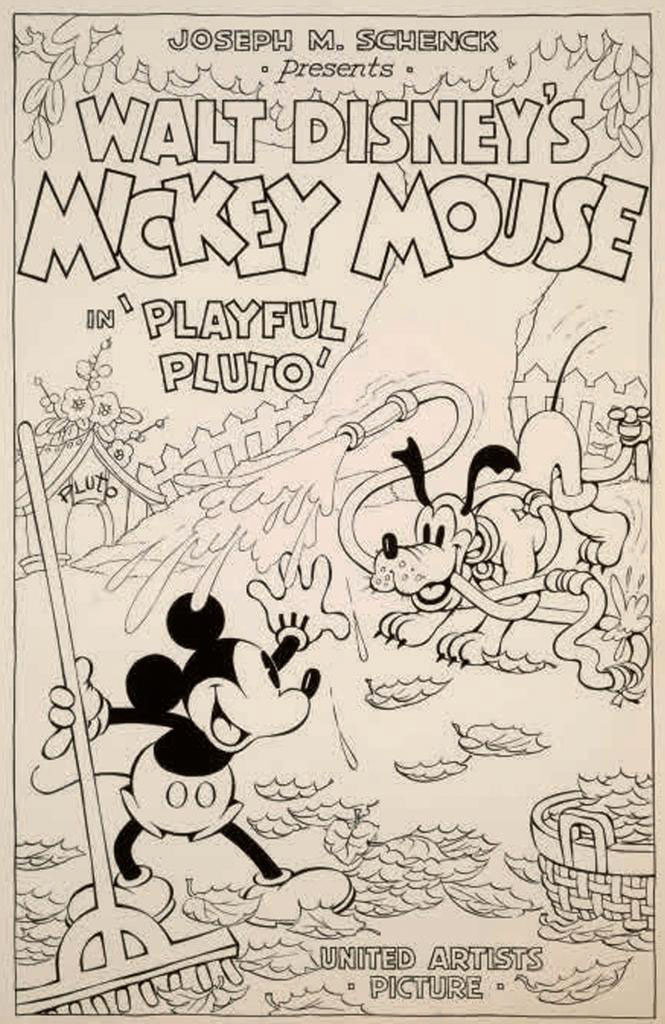 Playful Pluto (Disney/United Artists, Mickey Mouse, 3/3/34 – Burt Gillett, dir.) is a pure demonstration of the strength of character personality, rather than worrying about much of a plot. It simply follows a typical day of mishaps around the Mickey household, with Pluto running afoul of a basket full of leaves, a garden hose, swallowing a flashlight, getting tangled-up in a wardrobe dresser, and a memorable sequence stuck in flypaper. (Disney must have felt the flypaper sequence got strong audience reaction, as he would find excuses to reuse it on two subsequent occasions – both incorporating the animation into a Technicolor redraw for a portion of Donald Duck’s 1939 short, The Beach Picnic, and lending out the original black and white sequence for use by director Preston Sturges for a finale sequence in the Paramount feature, Sullivan’s Travels, where the would-be film producer serving as the title character, down and out in jail, comes to the realization that heavy drama is not the most satisfying material for an audience – based on the hilarious laughter of the prison audience at the comedic screening of the Mickey Mouse cartoon.
Playful Pluto (Disney/United Artists, Mickey Mouse, 3/3/34 – Burt Gillett, dir.) is a pure demonstration of the strength of character personality, rather than worrying about much of a plot. It simply follows a typical day of mishaps around the Mickey household, with Pluto running afoul of a basket full of leaves, a garden hose, swallowing a flashlight, getting tangled-up in a wardrobe dresser, and a memorable sequence stuck in flypaper. (Disney must have felt the flypaper sequence got strong audience reaction, as he would find excuses to reuse it on two subsequent occasions – both incorporating the animation into a Technicolor redraw for a portion of Donald Duck’s 1939 short, The Beach Picnic, and lending out the original black and white sequence for use by director Preston Sturges for a finale sequence in the Paramount feature, Sullivan’s Travels, where the would-be film producer serving as the title character, down and out in jail, comes to the realization that heavy drama is not the most satisfying material for an audience – based on the hilarious laughter of the prison audience at the comedic screening of the Mickey Mouse cartoon.
The opening sequence of the film involves a freak weather condition, as a pint-sized whirlwind upsets a basket of leaves Mickey has raked up from the lawn. The small cyclone sucks up the leaves within its cone, then leads Mickey on a brief chase across the yard. When Mickey trips, allowing the basket to fall from his arms, the cyclone gives up the game, and harmlessly deposits all the leaves back in the basket, then departs. But Pluto continues to pursue, leaping into the basket, and scattering all of Mickey’s work everywhere. This brief sequence would again find an afterlife, later being expanded into the nucleus for a fine solo short in color for Mickey, The Little Whirlwind (1941).
 Cubby’s Stratosphere Flight (Van Buren/RKO, Cubby Bear, 4/20/34 – George Stallings, dir.) Call it professional jealousy. Not content to let the visiting West Coast boys steal their thunder, the New York staff tries their own hand at getting Cubby airborne. The results are not nearly as satisfying, nor lineal in plot progression. Cubby and his girl set up the launch of Cubby’s latest airship. No, it’s not a plane, nor dirigible. Instead, Cubby stands in a wooden washbucket, with a harness fastened to the neck collar of a pelican, and holds in front of the pelican’s nose a fish suspended on the end of a line from a fishing pole. The pelican follows the fish like a mule following a carrot, and Cubby is towed high aloft upon the strength of the pelican’s wings. Unfortunately, once up in the clouds, a second smaller pelican emerges from the first’s beak, able to reach out and grab the fish off of Cubby’s line, depriving the birds of further motivation. A grotesque cloud face sticks out its “tongue” as a lightning bolt, also developing a hairdo of gathering snow. Its bolt splits into a pair of scissor blades, and slices the harness between the pelican and Cubby’s bucket. Cubby goes into free fall, while another cloud opens a front door much like an igloo, and two cloud-men from within shovel out the door loads of snow, followed by setting up an electric fan to blow the snow at Cubby at gale force. Cubby plummets amidst the driving snowstorm, and crashes into the traffic control station of a polar bear cop at the North Pole. Cubby’s bucket slides and crashes into an igloo, which is the entrance to an arctic cabaret (with a quartet of walrus singing waiters, who take up nearly two minutes of the remaining footage in song). One of the only gags that generates a laugh in this segment is Cubby secretly whispering an order into the ear of one of the waiters, as if attempting to acquire a forbidden substance such as hooch during prohibition. The waiter looks around cautiously before speaking, then informs Cubby in clandestine fashion that they have what he desires – an ice cream cone in the frozen North. The cop enters the club, disgruntled about Cubby’s landing, and a chase results in Cubby inside a rolling, ever-growing snowball, that rolls all the way from the pole back to Cubby’s home, where his girl greets her hero with affectionate kisses for the iris out.
Cubby’s Stratosphere Flight (Van Buren/RKO, Cubby Bear, 4/20/34 – George Stallings, dir.) Call it professional jealousy. Not content to let the visiting West Coast boys steal their thunder, the New York staff tries their own hand at getting Cubby airborne. The results are not nearly as satisfying, nor lineal in plot progression. Cubby and his girl set up the launch of Cubby’s latest airship. No, it’s not a plane, nor dirigible. Instead, Cubby stands in a wooden washbucket, with a harness fastened to the neck collar of a pelican, and holds in front of the pelican’s nose a fish suspended on the end of a line from a fishing pole. The pelican follows the fish like a mule following a carrot, and Cubby is towed high aloft upon the strength of the pelican’s wings. Unfortunately, once up in the clouds, a second smaller pelican emerges from the first’s beak, able to reach out and grab the fish off of Cubby’s line, depriving the birds of further motivation. A grotesque cloud face sticks out its “tongue” as a lightning bolt, also developing a hairdo of gathering snow. Its bolt splits into a pair of scissor blades, and slices the harness between the pelican and Cubby’s bucket. Cubby goes into free fall, while another cloud opens a front door much like an igloo, and two cloud-men from within shovel out the door loads of snow, followed by setting up an electric fan to blow the snow at Cubby at gale force. Cubby plummets amidst the driving snowstorm, and crashes into the traffic control station of a polar bear cop at the North Pole. Cubby’s bucket slides and crashes into an igloo, which is the entrance to an arctic cabaret (with a quartet of walrus singing waiters, who take up nearly two minutes of the remaining footage in song). One of the only gags that generates a laugh in this segment is Cubby secretly whispering an order into the ear of one of the waiters, as if attempting to acquire a forbidden substance such as hooch during prohibition. The waiter looks around cautiously before speaking, then informs Cubby in clandestine fashion that they have what he desires – an ice cream cone in the frozen North. The cop enters the club, disgruntled about Cubby’s landing, and a chase results in Cubby inside a rolling, ever-growing snowball, that rolls all the way from the pole back to Cubby’s home, where his girl greets her hero with affectionate kisses for the iris out.
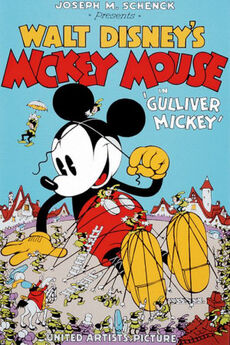 Gulliver Mickey (Disney/United Artists, Mickey Mouse, 5/19/34 – Burt Gillett, dir.) – The interesting first animated filming based off the Jonathan Swift classic. It was not the first film adaptation, there having been three silent films derived from the work, including one by effects wizard Georges Melies. However, its influence in the framing of many scenes while Mickey is tied down by the Lilliputians and in the sea attack is quite evident for fans of the 1939 Fleischer feature, with resemblances in the later film’s direction appearing more than accidental.
Gulliver Mickey (Disney/United Artists, Mickey Mouse, 5/19/34 – Burt Gillett, dir.) – The interesting first animated filming based off the Jonathan Swift classic. It was not the first film adaptation, there having been three silent films derived from the work, including one by effects wizard Georges Melies. However, its influence in the framing of many scenes while Mickey is tied down by the Lilliputians and in the sea attack is quite evident for fans of the 1939 Fleischer feature, with resemblances in the later film’s direction appearing more than accidental.
Relationship (if any) of Mickey to the flock of young mice to whom he relates the story is blurred by one line of dialogue, in which our hero refers to himself as “Uncle Mickey”. The mice, however, appear to be the same flock of “orphans” who appeared in such films as “Orphans’ Benefit”, “Orphans’ Picnic”, and “Mickey’s Circus”, so it is unknown if Mickey is only referring to himself as an “uncle” on a friendly rather than genealogical basis. The writers’ intentions become even more indistinct when one realizes that in the same year, two mice who could have come out of the same troupe made their only theatrical appearance as nephews Morty and Ferdie in “Mickey’s Steam-Roller”. It is also curious that Mickey is interacting with the youths on an invitation basis in his own parlor, rather than at a formal social event as in the three “Orphans” titles named above, also suggesting that the original intent might have been to let Mickey have a large extended family. (What relative mouse in his family line had experienced for-real “Mickey’s Nightmare”?)
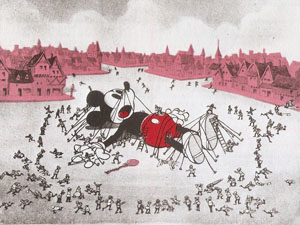 Much of the storm that shipwreck Mickey is related verbally, with Mickey providing his own special effects in the living room, simulating thunder and lightning through the rattling of a window shade and the switching on and off of a light bulb. He provides vocal effects for the wind whistling (which one of the junior mice lampoons by responding with a short whistle sounding like the call, “yoo-hoo”), then another of the little mice provides a “howl” by pulling Pluto’s tail. The scene then dissolves to a realistic shot of Mickey being tossed about on top of ocean waves, amidst a thunder-laden black sky. The wave crests form into the typical hands to play a game of catch with the mouse as ball, then Mickey states to his audience that “a big wave picked me up and rolled me up on the beach.” This is cleverly illustrated by the watery “hand” pitching Mickey as if he were a pair of dice in the hands of a nimble crap-shooter, punctuating the roll with a snap of its fingers as if eagerly anticipating a point of seven. Another nice piece of literal comedy follows as Mickey falls asleep on the beach, while his narration continues, “And then, day broke!” On cue, the entire night sky cracks apart like a pane of shattering glass, revealing the sunlit sky of dawn behind it. Mickey awakens to find himself bound to the ground in the usual manner by the Lilliputians. Unlike Fleischer’s Gulliver, Mickey treats the whole affair with a degree of playfulness and mischief, showing little respect for the Lilliputians’ pomp and ceremony (flustering the King in the middle of a speech by repeatedly tickling the King’s rear end with his finger), and treating their cannons, ships, and other weaponry like little-nuisance toys (though seeming to take considerable pains to shield his own large eyes from their barrage of tiny cannonballs). He does, however, share a moment of concern with Fleischer’s Gulliver when several of the sailors jump into the sea, and he carefully scoops them up in his hands and places them back aboard their ship. Things entirely deviate from both the later feature and from the book itself, as the writers opt for a completely off-the- wall ending, having Lilliput attacked by a giant spider – so large, he even dwarfs Mickey. (Where did he come from – Brobdingnag?) Mickey bravely battles the beast in a furious round of fisticuffs, the action dissolving back into Mickey’s living room, where he illustrates the battle by beating up on a large pillow. One of the little mice breaks up the whole affair by debunking Mickey’s courage, holding over his head a toy spider suspended from the line of a fishing pole. Mickey freaks out at the sight of it, jumping to the ceiling and bringing down a light fixture upon his head in the process, and ends the picture laughing at himself and the joke played upon him, for the iris out.
Much of the storm that shipwreck Mickey is related verbally, with Mickey providing his own special effects in the living room, simulating thunder and lightning through the rattling of a window shade and the switching on and off of a light bulb. He provides vocal effects for the wind whistling (which one of the junior mice lampoons by responding with a short whistle sounding like the call, “yoo-hoo”), then another of the little mice provides a “howl” by pulling Pluto’s tail. The scene then dissolves to a realistic shot of Mickey being tossed about on top of ocean waves, amidst a thunder-laden black sky. The wave crests form into the typical hands to play a game of catch with the mouse as ball, then Mickey states to his audience that “a big wave picked me up and rolled me up on the beach.” This is cleverly illustrated by the watery “hand” pitching Mickey as if he were a pair of dice in the hands of a nimble crap-shooter, punctuating the roll with a snap of its fingers as if eagerly anticipating a point of seven. Another nice piece of literal comedy follows as Mickey falls asleep on the beach, while his narration continues, “And then, day broke!” On cue, the entire night sky cracks apart like a pane of shattering glass, revealing the sunlit sky of dawn behind it. Mickey awakens to find himself bound to the ground in the usual manner by the Lilliputians. Unlike Fleischer’s Gulliver, Mickey treats the whole affair with a degree of playfulness and mischief, showing little respect for the Lilliputians’ pomp and ceremony (flustering the King in the middle of a speech by repeatedly tickling the King’s rear end with his finger), and treating their cannons, ships, and other weaponry like little-nuisance toys (though seeming to take considerable pains to shield his own large eyes from their barrage of tiny cannonballs). He does, however, share a moment of concern with Fleischer’s Gulliver when several of the sailors jump into the sea, and he carefully scoops them up in his hands and places them back aboard their ship. Things entirely deviate from both the later feature and from the book itself, as the writers opt for a completely off-the- wall ending, having Lilliput attacked by a giant spider – so large, he even dwarfs Mickey. (Where did he come from – Brobdingnag?) Mickey bravely battles the beast in a furious round of fisticuffs, the action dissolving back into Mickey’s living room, where he illustrates the battle by beating up on a large pillow. One of the little mice breaks up the whole affair by debunking Mickey’s courage, holding over his head a toy spider suspended from the line of a fishing pole. Mickey freaks out at the sight of it, jumping to the ceiling and bringing down a light fixture upon his head in the process, and ends the picture laughing at himself and the joke played upon him, for the iris out.
 Pandora (Terrytoons/Educational – 6/1/34) – During this time period, Terry was introducing a pair of small nameless dogs, male and female, who provided a generic love couple to star in several adventures (similar to the mouse couple first introduced in Caviar). The dogs were white, but the male had a black patch over one ear – it thus appears that the male eventually became the visual model inspiration for the better-known Puddy the Pup. In this episode, the female dog assumes the role of Pandora. While she is cavorting outside with the male, a passing witch, whose announced hobby is to scare children at random, decides without provocation to cause trouble by slipping the legendary box into Pandora’s house through a window. Why she would design the box with an etched face on its side which sings a doomish warning against opening the box is a question, as the warning would seem to work against her own interests. Obviously, she is sufficiently satisfied that in spite of the warnings, the rule with children is “Curiosity killed the cat” – uh, make that dog. Another strange cross of motivations takes place as Pandora returns and approaches the box, hearing a voice from inside saying “Let me out.” The male dog tells her not to touch, reminding her of the box’s singing warning. But ourside the window, Pandora’s dog, who was previously referred to by a narrating chorus as “faithful”, oddly takes a different opinion, sarcastically stating through the window, “Go on. What have you got to lose?” The dog, now with apparently evil motivations, quickly packs up his dog house, and exits out of harm’s way. Some faithfulness! All manner of evil emerges when the box is opened, mostly in the form of a swarm of bird-bat cross-overs who sting like mosquitoes with devil tails, and also have the power to grow into giant monsters who musically introduce themselves as Fear, Hate, and Greed. They are also accompanied by large walking bottles of castor oil which chase after the kids with huge tablespoons loaded with the stuff, and, to keep within the theme of this trail, a large black cloud shaped like a devil, which sneaks up behind the sun, then grabs the glowing orb in its clutches, and squeezes until the sun pops out of existence. Three minutes of chasing is wrapped up by a good fairy, Hope, appearing out of the box, to right all wrongs with a wave of a wand. (How did she get in the witch’s box? Wouldn’t the witch have a much more effective weapon had she not included within it an instant antidote? Oh, well, you just can’t find a good magic spell on the market these days without some killjoy side-effect to louse it up.)
Pandora (Terrytoons/Educational – 6/1/34) – During this time period, Terry was introducing a pair of small nameless dogs, male and female, who provided a generic love couple to star in several adventures (similar to the mouse couple first introduced in Caviar). The dogs were white, but the male had a black patch over one ear – it thus appears that the male eventually became the visual model inspiration for the better-known Puddy the Pup. In this episode, the female dog assumes the role of Pandora. While she is cavorting outside with the male, a passing witch, whose announced hobby is to scare children at random, decides without provocation to cause trouble by slipping the legendary box into Pandora’s house through a window. Why she would design the box with an etched face on its side which sings a doomish warning against opening the box is a question, as the warning would seem to work against her own interests. Obviously, she is sufficiently satisfied that in spite of the warnings, the rule with children is “Curiosity killed the cat” – uh, make that dog. Another strange cross of motivations takes place as Pandora returns and approaches the box, hearing a voice from inside saying “Let me out.” The male dog tells her not to touch, reminding her of the box’s singing warning. But ourside the window, Pandora’s dog, who was previously referred to by a narrating chorus as “faithful”, oddly takes a different opinion, sarcastically stating through the window, “Go on. What have you got to lose?” The dog, now with apparently evil motivations, quickly packs up his dog house, and exits out of harm’s way. Some faithfulness! All manner of evil emerges when the box is opened, mostly in the form of a swarm of bird-bat cross-overs who sting like mosquitoes with devil tails, and also have the power to grow into giant monsters who musically introduce themselves as Fear, Hate, and Greed. They are also accompanied by large walking bottles of castor oil which chase after the kids with huge tablespoons loaded with the stuff, and, to keep within the theme of this trail, a large black cloud shaped like a devil, which sneaks up behind the sun, then grabs the glowing orb in its clutches, and squeezes until the sun pops out of existence. Three minutes of chasing is wrapped up by a good fairy, Hope, appearing out of the box, to right all wrongs with a wave of a wand. (How did she get in the witch’s box? Wouldn’t the witch have a much more effective weapon had she not included within it an instant antidote? Oh, well, you just can’t find a good magic spell on the market these days without some killjoy side-effect to louse it up.)
NEXT TIME: More, more, from ‘34.
